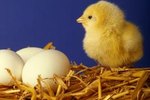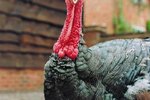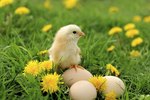
Muscovy ducks live throughout much of the Americas in the wild, and they're found throughout the world as domesticated poultry. Their bright red, bumpy masks make them look like they've borrowed facial features from turkeys. Muscovy ducklings' genders can be difficult to distinguish, but the difference becomes apparent as young as 4 weeks of age.
Ducklings
The only way to tell Muscovy ducklings apart at less than 4 weeks old is by vent-sexing -- turning the duckling over and examining the orifice beneath the tail. By pressing below and to the sides of the vent, it is possible to unsheathe the male duck's penis. You should wear gloves and lubricate the vent with a small amount of petroleum jelly beforehand. Improper vent-sexing can result in injury to the duckling.
Young Ducks
At about 4 weeks old, male ducks will be much larger than females, with thicker legs and bigger feet. The males will be nearly twice as big as the hens at maturity. You can also tell males by their longer chest-to-tail proportion, whereas females are more compact in the body relative to tail length.
Adult Ducks
Muscovy drakes display the characteristic red carbuncle mask that makes the breed unique. In dark-feathered Muscovy ducks, both sexes will exhibit an iridescent green glow in the sunlight, with male coloring more extensive.
References
Photo Credits
-
Hemera Technologies/Photos.com/Getty Images
Writer Bio
Indulging her passion for vacation vagary through the written word on a full-time basis since 2010, travel funster Jodi Thornton-O'Connell guides readers to the unexpected, quirky, and awe-inspiring.




